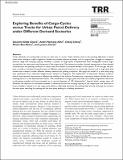| dc.contributor.author | Dalla Chiara, Giacomo | |
| dc.contributor.author | Alho, André Romano | |
| dc.contributor.author | Cheng, Cheng | |
| dc.contributor.author | Ben-Akiva, Moshe | |
| dc.contributor.author | Cheah, Lynette | |
| dc.date.accessioned | 2021-10-01T19:59:45Z | |
| dc.date.available | 2021-10-01T19:59:45Z | |
| dc.date.issued | 2020-05 | |
| dc.identifier.issn | 0361-1981 | |
| dc.identifier.issn | 2169-4052 | |
| dc.identifier.uri | https://hdl.handle.net/1721.1/132690 | |
| dc.description.abstract | Transportation Research Board 2020. Urban deliveries are traditionally carried out with vans or trucks. These vehicles tend to face parking difficulties in dense urban areas, leading to traffic congestion. Smaller and nimbler vehicles by design, such as cargo-cycles, struggle to compete in distance range and carrying capacity. However, a system of cargo-cycles complemented with strategically located cargo-storing hubs can overcome some limitations of the cargo-cycles. Past research provides a limited perspective on how demand characteristics and parking conditions in urban areas are related to potential benefits of this system. To fill this gap, we propose a model to simulate the performance of different operational scenarios—a truck-only scenario and a cargo-cycle with mobile hubs scenario—under different delivery demand and parking conditions. We apply the model to a case study using data synthesized from observed freight-carrier demand in Singapore. The exploration of alternative demand scenarios informs how demand characteristics influence the viability of the solution. Furthermore, a sensitivity analysis clarifies the contributing factors to the demonstrated results. The combination of cargo-cycles and hubs can achieve progressive reductions in kilometers-traveled and hours-traveled up to around densities of 150 deliveries/km2, beyond which savings taper off. Whereas the reduction in kilometers-traveled is influenced by the the carrying capacity of the cargo-cycle, the reduction in hours-traveled is related to to the cargo-cycle ability to effectively decrease the parking dwell time by reducing, for instance, the time spent searching for parking and the time spent walking to a delivery destination. | en_US |
| dc.language.iso | en | |
| dc.publisher | SAGE Publications | en_US |
| dc.relation.isversionof | 10.1177/0361198120917162 | en_US |
| dc.rights | Creative Commons Attribution NonCommercial License 4.0 | en_US |
| dc.rights.uri | https://creativecommons.org/licenses/by-nc/4.0/ | en_US |
| dc.source | Sage | en_US |
| dc.title | Exploring Benefits of Cargo-Cycles versus Trucks for Urban Parcel Delivery under Different Demand Scenarios | en_US |
| dc.type | Article | en_US |
| dc.identifier.citation | Dalla Chiara G, Alho AR, Cheng C, Ben-Akiva M, Cheah L. Exploring Benefits of Cargo-Cycles versus Trucks for Urban Parcel Delivery under Different Demand Scenarios. Transportation Research Record. 2020;2674(5):553-562 | en_US |
| dc.contributor.department | Massachusetts Institute of Technology. Department of Civil and Environmental Engineering | |
| dc.contributor.department | Singapore-MIT Alliance in Research and Technology (SMART) | |
| dc.relation.journal | Transportation Research Record | en_US |
| dc.eprint.version | Final published version | en_US |
| dc.type.uri | http://purl.org/eprint/type/JournalArticle | en_US |
| eprint.status | http://purl.org/eprint/status/PeerReviewed | en_US |
| dc.date.updated | 2021-10-01T16:44:36Z | |
| dspace.orderedauthors | Dalla Chiara, G; Alho, AR; Cheng, C; Ben-Akiva, M; Cheah, L | en_US |
| dspace.date.submission | 2021-10-01T16:44:37Z | |
| mit.journal.volume | 2674 | en_US |
| mit.journal.issue | 5 | en_US |
| mit.license | PUBLISHER_CC | |
| mit.metadata.status | Authority Work Needed | en_US |
